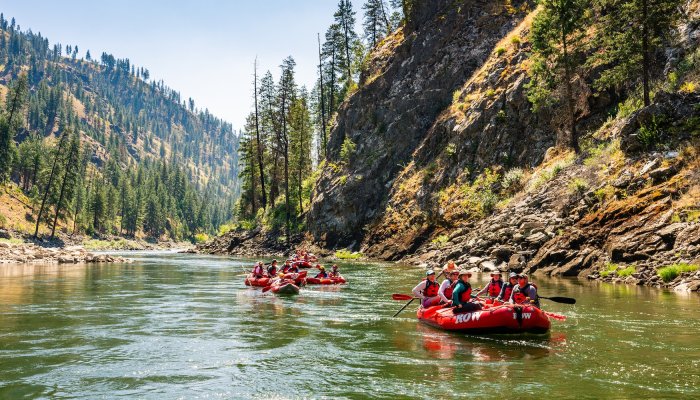A Landmark Case of River Restoration: the Elwha Dam Removal Project
For around a century, the Elwha River in Northwest Washington was fragmented by the construction of two large hydroelectric dams. Built in the early 20th century to provide power to the nearby city of Port Angeles, the Elwha Dam and the Glines Canyon Dam obstructed the natural flow of the river and blocked the upstream migration of Pacific Northwest salmon and other anadromous fish species. This man-made disruption to the Elwha's delicate ecosystem had significant consequences, decimating fish populations and dramatically altering the surrounding landscape.
In an act of ecological restoration, the Elwha Dam was demolished in 2012, followed by the removal of the Glines Canyon Dam just two years later. This historic undertaking (the largest dam removal project ever attempted) has set in motion an environmental transformation that is still ongoing. Today, the free-flowing Elwha River is on the road to recovery, with salmon and other migratory fish recolonizing their ancestral spawning grounds while the riverbanks and floodplains are bursting with life as the trapped sediments are gradually replenished.
For guests joining us on our Olympic Peninsula E-Bike Tour, the environmental implications of the Elwha River dam removal project will be particularly interesting as our route takes us along its course. In this article, discover the history of the dams, the impact they had on the natural ecosystem, and the process of environmental recovery following their removal.

Brief history of the Elwha River dams
The Elwha Dam was an engineering project undertaken in the early 20th century, spearheaded by Thomas Aldwell. Recognizing the hydroelectric potential of the Elwha River, he strategically acquired tracts of land along the waterway, laying the groundwork for the dam construction. With the financial backing of Canadian businessman George Glines, Aldwell broke ground on the Elwha Dam project in 1910.
However, he and his team neglected to build proper fish passages (disregarding the needs of the river's salmon populations) and failed to properly anchor the dam's foundation to the bedrock below. The latter would prove disastrous, as the partially completed dam faced a catastrophic failure in 1912 when the reservoir behind it became too full. The lower sections gave way, unleashing a torrential flood that swept away a nearby bridge.
Undeterred, Aldwell secured additional funding to reconstruct the dam, which was finally completed in 1913, resulting in the reservoir known as Lake Aldwell. The Elwha River Hydroelectric Power Plant historic district, encompassing the dam, powerhouse, and associated infrastructure, was later recognized for its historical significance, earning a listing on the National Register of Historic Places in 1988.
Together with the Glines Canyon Dam (which was constructed in 1926), the Elwha Dam was intended to fuel the region's economic growth and development by providing a reliable source of electricity to power local industries. In the decades that followed, the dams played a crucial role in supporting the area's timber and manufacturing sectors, enabling the expansion of mills, factories, and other businesses that were essential to the local economy.
However, by the early 21st century, the landscape had changed dramatically. The combined power output of the two dams was only providing around 38% of the electricity needed to operate a single sawmill - the Daishowa America mill. As newer, more efficient power generation technologies emerged and environmental concerns took center stage, the Elwha and Glines Canyon Dams found themselves struggling to keep pace.
Effects of the Elwha Dam on the riverine habitat
In addition to their declining importance in the region’s industrial landscape, the dams were having a detrimental impact on the downstream ecosystem, particularly in the lower reaches of the waterway. Prior to the dams, the river had carried a substantial sediment load, which was crucial for maintaining the health and integrity of the riverbed and delta. However, the dams effectively trapped this sediment, preventing it from flowing downstream as it had for centuries.
As a result, the lower reaches of the river experienced a dramatic decrease in the amount of sediment being delivered, leading to a net erosion of the riverbed. This erosion was especially problematic for the gravelly habitats needed by spawning salmon. Local tribal leaders, who have long depended on the salmon runs, confirmed that the delta at the river's mouth, where it empties into the Strait of Juan de Fuca, had experienced significant erosion due to the disruption of the natural sediment flow.
The creation of Lake Aldwell and Lake Mills as a result of the damming projects had a profound impact on the river ecosystem beyond just the issue of sediment retention. Most notably, the long residence time of the water in these newly formed lakes caused a significant warming of the water temperatures, which had consequences for the local fish populations. Whereas the natural river waters would typically remain near the 32°F (0°C) mark, the stagnant lake waters were able to heat up to 60°F (16°C) - a temperature far too high for the optimal spawning and breeding conditions that the native salmon and trout species required.
The elevated temperatures also created ideal conditions for parasites and other pathogens to proliferate, leading to disease outbreaks that decimated returning salmon runs. One such incident in 1992 is estimated to have wiped out two-thirds of an entire Chinook salmon population before they could even reach their spawning grounds.
The Elwha River fisheries
At the height of its productivity, the Elwha River supported bountiful spawning runs of Chinook, coho, chum, pink, and sockeye salmon, as well as steelhead, cutthroat, and bull trout. The Chinook salmon in particular were known to reach massive sizes, with some individuals growing to 100 pounds (45 kilograms).
However, the construction of the Elwha and Glines Canyon dams blocked access to the river's prime spawning grounds located upstream, cutting off the salmon and trout from the critical habitats they needed to successfully reproduce. As a result, several of the Elwha's salmon runs became endangered and teetered on the brink of extinction.
The gravels that had previously blanketed the river bottom, providing essential spawning habitat for salmon and other fish, were also steadily washed away. These gravels are considered a critical resource for the preservation of salmon habitats, as they create the ideal conditions for these fish to lay and incubate their eggs.
So even if modern fish passage systems had been installed, the dams would have continued to pose a major barrier to the recovery of these species. Ultimately, the only way to truly restore the Elwha's once-thriving salmonid populations was through the complete removal of both the Elwha and Glines Canyon dams, which would reopen access to the river's prime spawning habitats located far upstream.
The removal of the Elwha River dams
The Elwha River Ecosystem and Fisheries Restoration Act of 1992 was a landmark piece of legislation that provided critical funding and government support to address the long-standing environmental issues caused by the Elwha River dams. It recognized the urgent need to remove both dams and restore the Elwha to its former glory.
However, the sheer volume of sediment that had accumulated behind the dams over the years presented a major logistical challenge. It was estimated that 34 million cubic yards of sediment had built up, with the majority trapped behind the Glines Canyon Dam. Releasing all of this sediment at once would have had catastrophic consequences, smothering and destroying the remaining habitats downstream, as well as the fragile coastal ecosystems at the river's mouth.
To address this, a carefully planned drawdown experiment was conducted on the Glines Canyon Dam. Over the course of a week, the lake level was gradually lowered by 18 feet, allowing the river to slowly cut into the existing delta and create a new channel. Crucially, this gradual process prevented a sudden, massive release of sediment, and a new delta began to form at the lowered lake level.
The removal of the Elwha River dams was projected to have a profound impact on the surrounding ecosystems. According to modeling, after the initial two-year dam removal period, the river would begin the process of reverting back to its natural, free-flowing state. One of the key anticipated outcomes was a significant increase in sediment discharge rates downstream from the dams.
Fish populations, which had been largely cut off from the upper reaches of the Elwha, were expected to quickly rebound and return to those upstream areas. While the river may never fully regain the historically massive salmon runs it once supported, the predictions indicated that over the course of 15-20 years or more, the salmon populations would recover to something resembling their pre-dam conditions.
Beyond just reviving the aquatic ecosystems, the draining of the two large reservoirs behind the dams - Lake Mills and Lake Aldwell - would also open up an additional 715 acres of terrestrial habitat. This restored land is anticipated to provide a significant boost to the region's elk populations by improving and expanding their available habitats.
A success story in progress
In practice, the removal of the dams on the Elwha River has been a long and complex process that is continuing to unfold. The physical removal of the two dams began on September 27, 2011 and was not completed until August 26, 2014. In the aftermath, there has been a level of uncertainty about exactly how the river would transform and evolve. This is because so few large-scale dam removal projects have been accompanied by such rigorous scientific study and monitoring.
But the early signs of success are promising. Hundreds of thousands of seeds have been replanted in the former reservoirs, attracting a diversity of wildlife that includes everything from Keen’s mice to American dippers. The salmon and steelhead that had long defined this stretch of the Olympic Peninsula have begun reclaiming their rightful place, returning in ever-growing numbers to the Elwha River.
Collectively, the research is showing that rivers can be restored following the removal of dams, inspiring people across the country (and the world) to consider similar large-scale projects. In the coming years, the Elwha River project is expected to serve as an invaluable model for understanding the long-term impacts and effectiveness of dam removal on a grand scale. It’s a reminder that we can make positive changes for the environment when we come together and the resilience of our natural world to recover from the brink of destruction.






